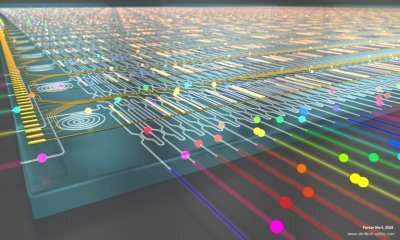Quantum photonics by serendipity

A photonic chip with no less than 128 tunable components proves to be a true computing "Swiss army knife" with a variety of applications. During her research on measuring light wavelengths using this photonic chip, Caterina Taballione of the University of Twente came across yet another application serendipitously—by sending single photons through the system instead of continuous light, the optical components can perform quantum operations, as well. The same chip works as a photonic quantum processor.
Manipulating light on a chip is now possible on a very advanced level, especially using combinations of materials. Researchers can build optical waveguides with very low losses using silicon nitride, or very narrow laser light sources using indium phosphide. The chip Caterina Taballione is presenting in her thesis contains many components that can either split or combine the light in and from separate channels, similar to a rail yard. It also has ring-shaped resonators that can work as a filter. The strength lies in the fact that the components can be controlled from the outside, making the chip flexible and programmable. It also has applications in quantum photonics.
Temperature control
The components are controlled via temperature. The chip has many so-called Mach-Zehnder interferometers that can split light from one to two light-conducting channels—waveguides. Before both channels rejoin, one of them can be controlled by applying a temperature variation. The result is that the signals from both channels are not the same: They have different phases. The ring-shaped components can also be temperature-controlled. In this way, Taballione was able to present a very precise way of measuring wavelengths of light. For this, she combine the temperature control to an artificial neural network.
5G
The system is highly reconfigurable. This makes it applicable in the upcoming 5G mobile standard. In this standard, wireless signals have to be directed from a base station to a user very precisely. Calculating the best combination of antennas for doing this, called "beam forming," is typically a task that the new chip can perform quickly, with high energy efficiency.
Quantum processing
These are all powerful applications showing the photonic chip's potential. But what about the case of separately detectable single photons at the inputs instead of a continuous light source? In that case, the components support typical quantum effects like coalescence, entanglement and superposition. The photons detected at the outputs are the result of quantum processing using the temperature control of the components. Although a single photon light source and detector typically operate at low temperatures, the quantum processor itself operates at room temperature.
Quantum computing using photons, therefore, has an advantage over the use of qubits, which only work at very cold temperatures. This turns the chip into a powerful platform for quantum experiments, especially when the number of inputs and outputs is further enlarged, and thus, the number of components. Including a single photon light source and detector would also make the system more powerful. The UT scientists involved therefore founded a new company called QuiX, to make the chip widely available for other scientists and R&D departments.
More information: Caterina Taballione. Integrated programmable waveguide circuits for classical and quantum photonic processing, (2019). DOI: 10.3990/1.9789036548038
Provided by University of Twente




















